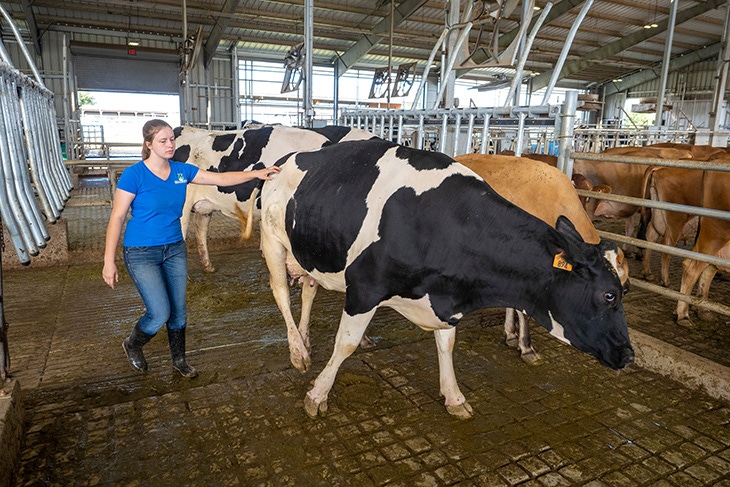Oklahoma State touts robotic milking system
Robotic milking systems increasingly becoming dairy industry’s default mode of business.
October 22, 2020

Candy is not just for people with a sweet tooth but is also a great way to train dairy cows how to use a robotic milking system, much to the delight and educational benefit of students working at Oklahoma State University’s Ferguson Family Dairy Center.
The robotic milking system highlights how the Oklahoma State University department of animal and food sciences provides students with firsthand experience of technological advances that are changing how the dairy industry does business, according to Nicole Sanders, Oklahoma State graduate student and interim dairy herd manager.
“If you want to work with high-tech agricultural companies in developing new programs and supporting new technology, we have that at Oklahoma State,” she said, adding that not many U.S. university undergraduate and graduate students "get to work with robotic milking systems.”
Training dairy cattle begins with a special kind of pelleted feed with sweets in it to entice the animals to enter the robotic milking system. This goes on for several weeks before the actual milking process starts. The idea is to get the cows used to the presence of the technology and eating the pellets, the announcement said.
“Everything has gone very well, especially with the Jersey cattle. After a while, it all becomes just a normal part of the cow’s day,” said Kristin Pronschinske with DeLaval, the manufacturer of the robotic milking system. “The students working at the center have had a lot of fun learning all about the new system and training the cows, and we have had just as much fun working with the students — and the cows.”
Oklahoma State agribusiness student Lora Wright agreed, noting how student access to cutting-edge technologies at the dairy center, combined with research-based educational experiences focused on best management practices, gives her and other dairy enthusiasts working at the center the practical, applicable skill set needed to pursue a variety of career options in the dairy industry.
“New technologies are an evolution in the dairy industry,” Wright said. “The center was the reason I came to Oklahoma State. Growing up on a registered dairy farm in southwestern Missouri, I wanted to continue that and pursue a degree in agriculture.”
Robotic milking systems are increasingly becoming the dairy industry’s default mode of business, in turn driving technological enhancements that affect related job functions — from feed advisors to veterinarians who are experienced with the interaction of animals and machines, to designers of dairy and other on-farm equipment, Oklahoma State said.
The university's Ferguson Family Dairy Center is "a working dairy farm, in addition to its role as a historically important research facility. The combination instills students who work there with a perspective that incorporates many different facets of the industry,” said Susan Allen, manager of industry affairs at Oklahoma Dairy MAX. “That is a valuable contribution to the industry, and to agriculture in general, in terms of turning out our next generation of producers, dairy scientists, livestock nutritionists, agricultural engineers, economic analysts, educators, entrepreneurs and community and government leaders.”
“The Ferguson Family Dairy Center clearly is an excellent educational and career-building resource for current [Oklahoma State] students, but from the outset, we also envisioned it being a place where busloads of third or fourth graders might come and see the latest innovations related to dairy production and animal management practices, maybe help them learn a little bit more about agriculture,” animal science department head Clint Rusk said. “We thought, potentially, some of them might even want to come to school here someday.”
For Wright, the technologies and programs at the center are examples of how life is changing for the dairy industry and those pursuing agricultural degrees.
She said at the dairy center, “we still milk some animals in the parlor, in addition to those going through the robotic milking system. The combination of traditional and cutting-edge practices gives students the best of both worlds and the knowledge to operate in each.”
You May Also Like



